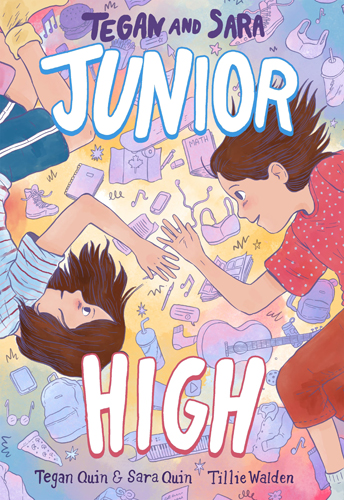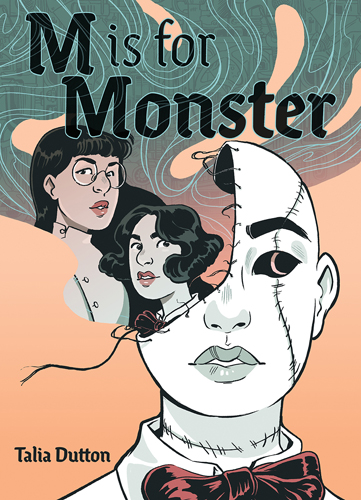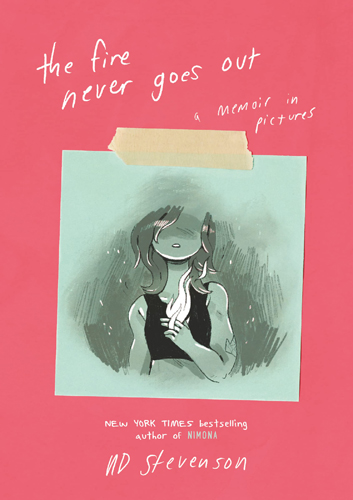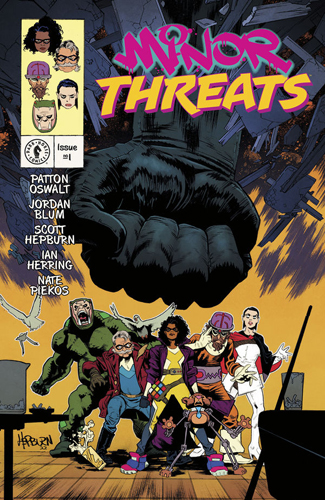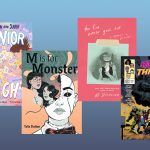
Well, hello, there! It’s been a while, but I’m still here, still reading a bit … just not managing to write as often. In the past month or so I’ve read a few comic books, finished one novel and started another, and also finished up Playing Oppression (which I mentioned in my last column). Today I’ll start with the comics.
Tegan and Sara: Junior High written by Tegan Quin & Sara Quin, illustrated by Tillie Walden
I’ll admit that I don’t know much about the pop duo Tegan and Sara other than that, well, they’re sisters and a pop duo. But I have enjoyed several of Tillie Walden’s comics and figured this would be a fun way to learn a bit about them. This comic is a fictionalized account—while the real Tegan and Sara started junior high in 1991, this book is set in the present day (which is why I was a bit confused at first by some of the pop-culture references that they made, or the fact that the kids have smartphones). But even though it’s been time-shifted and details have been rearranged, a lot of the story is based in reality: the twin sisters moved around a lot and had to deal with making new friends and new schools, discovering a love for music, and figuring out what to do with their feelings about girls.
The book is mostly in a purple-and-white color palette with occasional touches of other colors, but then also uses blues for Tegan and pink/red for Sara when we get to see some of their internal thoughts—sometimes their internal dialogue seems shared where they’re thinking at each other, and sometimes they’re each trapped in their own thoughts. The book reminded me a little of the Real Friends series by Shannon Hale, just in terms of navigating old and new friendships, dealing with bullies, and feeling out of place. For Tegan and Sara, there’s also the fact that they’re so close to each other and have always done things together, but then don’t click with the same people in junior high, which leads to some friction that’s a bit scary.
It’s a sweet story about how the two of them start to find their voices through music, and Walden’s illustrations do a great job of capturing their emotional states. According to the authors’ note at the end, there’s more to come, so we’ll get to see some continuing junior high adventures eventually!
M is for Monster by Talia Dutton
This comic book is sort of a Frankenstein’s monster tale: Maura dies in an accident during an scientific experiment, so her older sister Frances worked to bring her back to life—and that’s where the book begins, with the giant electric switch and the stitched-together body strapped to a table, the lab coats and gloves, and the “monster” waking up … but she doesn’t know who she is and has no memories of being Maura. Frances is sure that it’ll just take some time, some familiar places and routines, for everything to fall back into place, but M (as she calls herself) starts to realize that she really is just a different person altogether. She tries to behave the way Frances describes, but her likes and dislikes just aren’t the same.
The story is about expectations: what happens when we try to live up to somebody else’s expectations of us? How do we figure out who we are, when other people are telling us they already know who we should be?
The Fire Never Goes Out: A Memoir in Pictures by ND Stevenson
ND Stevenson is the author and illustrator of Nimona, as well as one of the cowriters of the Lumberjanes series, and was also a showrunner for the Netflix series She-Ra and the Princesses of Power. All of these resulted in a lot of attention at a fairly young age, which was a very intense experience. This book collects a series of sketches and comics, along with some “year in review” entries, that Stevenson wrote and drew between the years 2011 and 2019, a time when Stevenson was going to college, working on Nimona as a student project, interning at BOOM! Studios, and just getting started on She-Ra. Behind the scenes, though, Stevenson was often struggling—with what he has now revealed was a combination of bipolar disorder and ADHD, with the need to create art and the feeling that it isn’t enough, with the conflict between his evangelical upbringing and his own gender identity and romantic attraction. The book was published back in 2020, but since then Stevenson came out as trans (and changed his name and pronouns, so my copy of the book still has his old name on it). So while this memoir certainly seems incomplete and there’s a lot more to Stevenson’s own story yet to be lived, it’s a window into a tumultuous time, with some really powerful illustrations. Stevenson often portrays himself with either a hole through his chest, or a fire burning, and the book covers a time when he started figuring some of that out for himself.
Minor Threats written by Patton Oswalt and Jordan Blum, illustrated by Scott Hepburn
Minor Threats is set in a world full of costumed heroes and villains, and its protagonists are some of the low-level bad guys, the ones who made a name for themselves “before the alien invasions, the time travelling despots, and secret multiversal wars.” They’re seen hanging out at the Lower Lair, a bar run by the woman who used to be Playtime (sidekick of the Toy Queen, pulling heists using various toy-based weapons and tools). They reminisce about the good old days and try to pretend they’re not all washed up. But then everything changes: the Stickman, one of the new villains, has killed the Insomniac’s sidekick, breaking one of the unwritten rules of the game, and now the Insomniac is striking to kill. The heroes have put the city into a lockdown, searching for the Stickman, and the bad guys have nowhere to run. So Playtime gets her costume back out, pulls together a team of has-beens, and comes up with a plan to take out Stickman themselves to get the heroes off their backs.
It’s a comic that plays with various superhero tropes—we get some villain origin stories as the various characters take turns being the narrator-voice-bubble, and there’s a wide variety of powers on display. Playtime can make complex machine out of almost anything; Brain Tease can analyze a situation and figure out where things are going; Snake Stalker is just an enormous guy in a snake suit. But the Stickman seems to be one step ahead of them the whole time, and they find themselves walking into one trap after another.
I enjoyed it for the most part—it reminded me a little of Kurt Busiek’s Astro City series just with the way the world was populated with so many costumes, though Minor Threats feels a lot meaner and is definitely a lot more gruesome. There’s a lot of blood and gore, so if you’re at all squeamish you may want to skip it. It’s a villain’s-eye-view of a world getting turned upside down, and both the heroes and the villains have to figure out how they’re going to survive in it.
My Current Stack
I’ve read a few others that I’ll share down the road: Wild Massive by Scotto Moore is a sci-fi novel about a multiverse inside a building and it’s wacky and wonderful. How to Love is a guide to feelings and relationships by Alex Norris, the “oh no” comic strip artist. And I just picked up a copy and started Atomic Anna because I found out at my reunion that it’s a time travel novel written by one of my college classmates, Rachel Barenbaum.
Disclosure: I received review copies of the books covered in this column; affiliate links to Bookshop.org help support independent booksellers and my writing!
Click through to read all of "Stack Overflow: Comics Grab-Bag" at GeekDad.If you value content from GeekDad, please support us via Patreon or use this link to shop at Amazon. Thanks!

